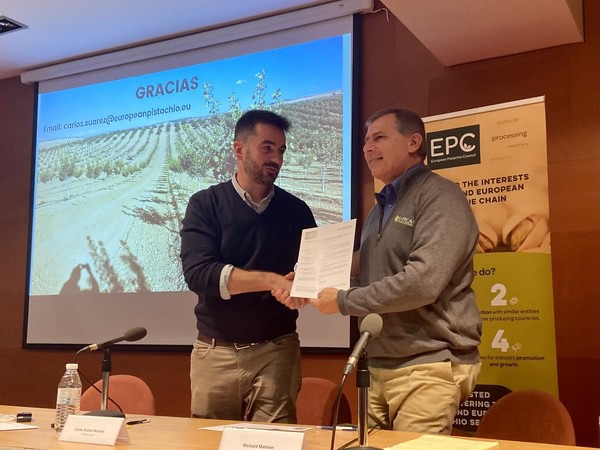“Spain and some producing areas of Mediterranean Europe are experiencing the emergence of pistachio, but, compared to California, we are like a drop of water in the ocean. There are synergies that we should all take advantage of. If we want to maintain the current profitability, we have to increase consumption and be more competitive. That means we must be organized, improve our efficiency, and explore ways of collaborating with the US.”
That was the main conclusion made by Carlos Suarez, president of the European Pistachio Council (CEP), after signing an agreement with his counterpart from American Pistachios Growers (APG), Richard Matoian. The agreement between both entities will allow them to share information, organize congresses and joint visits, and identify future collaboration projects.

Suarez and Matoian met this weekend at the fairgrounds of Talavera de la Reina (Toledo) and analyzed the situation of pistachio on both sides of the Atlantic and the differences between both models. Europe's pistachio sector is quite incipient while the US sector is very mature. The US produces 590,000 tons of pistachio and is the undisputed world-leading producer. California's pistachio is based on intensive high-yielding irrigated systems. Meanwhile, the Spanish pistachio is mostly grown in rainfed areas or with irrigated support, but it has the potential to become the world's fourth-biggest producer thanks to the large area it has available for cultivation and the logistical advantage of being within the EU's single market. But both share an interest: increasing pistachio consumption as a healthy product in Europe.
The CEP includes a good part of the main pistachio producers (which are mainly Spanish), but also processors, marketers, nurseries, as well as machinery and services companies from the main European cultivation areas. Greece leads this group's production with some 8,000 tons produced in nearly 10,000 hectares. However, it doesn't have the possibility of expanding its production. It is followed by Spain with 4,500 tons and more than 66,000 hectares planted, only 10% of which are currently in production. Sicily (Italy) ranks third with 2,000 tons and 5,000 hectares. However, its growth is also limited because it is an island.
APG is an association representing more than 800 large producers, processors, and marketers from California, Arizona, and New Mexico. As its president clarified, the North American sector only directs 31% of its production to the domestic market, the rest - 69%– is mainly exported to Europe (24%), China and Hong Kong (21%), and Africa and the Middle East (12%).
For more information:
Consejo Europeo del Pistacho
www.consejoeuropeodelpistacho.com
